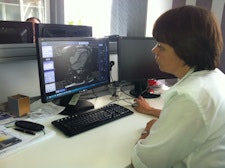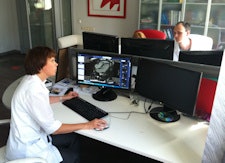
Modern Russia is a land of tremendous teleradiology opportunities, if you are prepared to join a process that resembles the Gold Rush in the Wild West. The expansion of Russian teleradiology is inevitable: A country with nine time zones can develop its own 24/7 teleradiology workflow just within its territory. Simply put, Russian teleradiology is imperative to keep the nation's healthcare running.
If any country needs teleradiology, it has to be the Russian Federation. The largest territory in the world, Russia presents a perfect teleradiology case study of extremely unevenly distributed healthcare, concentrated in Moscow and spread thinly outside of the capital, over an enormous area and sparse population. This unevenness deeply affects the quality and availability of radiological services, and cries out for teleradiology solutions. However, the same unevenness frequently acts against the advancement of teleradiology, blocking its natural progress.
Furthermore, the ironic Gogol's words about two major Russian problems -- "fools and roads" -- apply perfectly to teleradiology, where they translate into the lack of experts and adequate IT infrastructure.
 Practicing teleradiology in Russia. Image courtesy of Dr. Elena Mershina.
Practicing teleradiology in Russia. Image courtesy of Dr. Elena Mershina.
I was involved in several teleradiology projects in Russia with varying aims and success. This taught me a few lessons about the present and possible future of Russian teleradiology, which I would like to share in this article.
Without question, teleradiology builds upon conventional digital radiology, DICOM, and PACS -- fields that had been largely underdeveloped in Russia for years. For that reason alone, the country is trying to catch up now, mainly through escalated imports of digital diagnostic equipment (308 million euros [12.3 billion rubles] in 2010 versus 78 million euros [3.1 billion rubles] in 20051). On one hand, this means that Russian radiologists are getting better-equipped and becoming more familiar with the same CT, MR, or digital radiography scanners used by their European or U.S. colleagues. On the other hand, the number of Russian radiologists (1.3 per 10,000 people) has not grown since the 1980s. Expanding equipment resources without providing proper training only stresses the serious lack of qualified radiologists, even in the most technologically advanced areas such as Moscow or St. Petersburg.
Networking is another critical component of any teleradiology project. However, the presence of hospital-wide DICOM/PACS networks in Russian hospitals still remains extremely limited: Russia visibly lacks qualified IT personnel to set up and run its digital medicine "in the trenches." Instead, networking tasks are commonly delegated to the equipment vendors or even tech-savvy medical doctors.
This leads to a rather paradoxical situation, when the most modern of digital equipment is still used in a most primitive way: printing film. It also means that radiologists remain chained to their scanners, unable to access them otherwise -- an unacceptable luxury for contemporary radiology, built around "reading rooms." Therefore, when images have to be exchanged for remote consultations, they are often shared in the most archaic ways; if not on film, then as JPEG emails2 of file transfer protocoled DICOM files -- at best, a Stone Age of modern teleradiology.
 It is harder to practice teleradiology in Russia because not as much development exists. Image courtesy of Dr. Elena Mershina.
It is harder to practice teleradiology in Russia because not as much development exists. Image courtesy of Dr. Elena Mershina.
The same "import" problem plagues Russian teleradiology software and standards. Imported proprietary software solutions are often confused with the standards, and patchy vendor-specific networks with DICOM. Delegating hospital networking to radiology vendors leads to inevitable chaos, ruling out any possibility of implementing pragmatic teleradiology systems. But even when teleradiology networks are built, they are built in the heaviest possible way: as point-to-point DICOM connections between hospitals. This often overloads underperforming Russian networks; many remote Russian areas can only be reached via satellite, making large data transfers prohibitively expensive. The remedy to this problem is lightweight Web-based, cross-browser/platform teleradiology clients, but they are still largely unknown in Russia.
The time has come to realize that teleradiology cannot be bought or imported; it has to be competently organized. For Russian teleradiology to succeed nationwide, it is imperative to start investing in IT-aware radiologists and radiology-aware IT; both capable of making sense of otherwise disconnected devices and data. These experts cannot be imported; they have to be trained. Their very existence will define the future of Russian teleradiology.
Financial matters
The average monthly salary of a Russian radiologist outside of Moscow dwells well below the Apple iPad price tag -- making him or her genuinely uninterested in any new technology. Occasional governmental financial injections and local kickbacks do not help. As a result, most Russian radiologists have yet to develop a personal interest in teleradiology. The lack of adequate compensation creates another teleradiology bottleneck: conflicts of interest. For instance, underpaid radiologists tend to view patients as their personal source of income. Naturally, this undermines the entire concept of clinical data sharing: Why should I share "my" patients with anyone else? I have seen hospitals where radiology departments started with centralized PACS, but degraded into a mess of individual USB drives used by radiologists to store "their patients' images." Forget about teleradiology.
 The Russian Federal Rehabilitation Center launched its own teleradiology portal.
The Russian Federal Rehabilitation Center launched its own teleradiology portal.Fortunately, things are starting to change in busy and technologically advanced hospitals where large patient flows put quality and optimal service above personal insecurities. Business brings discipline. For example, the Russia Federal Rehabilitation Center launched its own teleradiology portal (see image above), where any radiologists and patients can upload and view their DICOM images and get a professional second opinion.3 The Russian Federal Emergency Medicine Center in St. Petersburg actively experiments with lightweight teleradiology clients, including their use with satellites and robots. Educated and cost-aware Russian patients represent another driving force behind teleradiology: Flying from Vladivostok to Moscow for an expert opinion takes the same amount of time and money as flying to Boston or Tel-Aviv, making the patients extremely interested in remote image interpretation and the substantial savings it offers (not to mention saving lives).
Teleradiology is unthinkable without hospitals managing their clinical data and finances. Teleradiology should be driven by interhospital relationships and clinical priorities, and governed by internationally recognized quality standards. More and more, Russian hospitals are coming to this understanding, but they are still searching for the sustainable financial means to make it work.
Government versus private
The Russian Ministry of Health has spent years chasing its own tail with countless initiatives for a centralized -- or worse, "national" -- hospital information system (HIS) and PACS. The result was rather upsetting: While hasty concepts followed each other by biting the dust, commercial HIS, PACS, and teleradiology developers (Russian included) kept drowning in obscure, ever-changing governmental regulations.
Somehow the Russian government -- and its regional branches -- became particularly attached to the idea of centralized and center-run clinical data exchange. Instead of building teleradiology from the bottom up, as it should be built, they kept dreaming about the perfect solution that they could design and distribute nationwide. In reality, all this boils down to an infinite debate over "typical/national HIS" or "typical/national PACS," breeding corruption and vendor lobbyism, and leading to a bottleneck of true teleradiology projects. I have seen cases when governmental hospitals were asked to wait for the centralized solution in the midst of purchasing commercially available products. Undoubtedly, this disruptive nonsense led to a good deal of skepticism; the Russian Association of Medical Information Technology Development spends most of its time fighting with governmental appointees and corruption. Disputes and conflicts of power make the easiest things impossible: When I had to get an optional PACS certification for a commercial teleradiology system a year ago, no one knew how it could be done, but everyone wanted to sell it to me.
This lack of structure can be filled only with private initiatives, and they are starting to emerge. For example, the Russian LDC-MIBS network opened some 60 diagnostic MRI centers in 40 Russian cities, apparently using DICOM connectivity between them. The Russian Department of Railroads started its own privately held telemedicine program partially built around networked Russian railroads including a couple of hospital trains. It hopes to adopt teleradiology, but this is yet to be seen. Even state-run hospitals are trying to use their sporadic funding and grants to solve the teleradiology puzzle. These projects help radiology experts reach the most remote areas, as well as dealing with their local problems.
"Since three years, teleradiology helped us run our CT scans around the clock," confirmed Dr. Valentin Sinitsyn, PhD, chair of the radiology department at the Federal Medical and Rehabilitation Center in Moscow. "Our radiographers perform the emergency scans onsite, three per night on average, while our radiologists read them remotely from home using a Web-based teleradiology interface. We are looking at smartphones to make this access even more convenient."
Some of my Moscow-based colleagues have started to consult each other remotely; commuting in notorious Moscow traffic jams does not make any sense.
Smarter patients
Interestingly enough, Russian skepticism for national healthcare has become another driving force behind emerging Russian teleradiology. Soon after the fall of the Iron Curtain, Russia turned itself into a society of "healthcare tourists;" wealthy Russians went abroad to seek medical assistance. Currently, Germany, Israel, and the U.S. have become the major destinations for middle-class Russian patients shopping for better healthcare. Healthcare tourism implies that the Russians have to get their initial scans in Russian hospitals, which must then share the images with their partners abroad. This inevitably draws Russian hospitals into the entire international teleradiology domain, and by necessity, it also brings foreign teleradiology groups to Russia.
Presently, this area still lacks any structure and legislation: Different training, different languages, and different fees are thrown into the same boiling borscht of Russian healthcare tourism. But this undoubtedly motivates Russian healthcare providers to start networking their data in more modern and standard ways; mailing CDs abroad simply does not work, nor does it make practical sense.
The future
The principal problem facing teleradiology in Russia is how to grow the golden fruits without getting severe food poisoning. One solution is to continue the adoption of foreign technology. The obvious underdevelopment of the Russian national PACS industry can be used by foreign teleradiology vendors: We can see more and more of them entering Russia's healthcare market. In fact, the only thing restraining their complete proliferation is their pricing: Remote Russian hospitals, rural ones in particular, simply cannot afford foreign price tags.
The other solution is to continue with Russian-based teleradiology projects and systems, but this calls for a substantial investment in developing expertise and providing competitive incentives. Without the investment, Russian teleradiology products and software will continue to look like pale imitations of Western originals, leaving the country permanently behind in the clinical IT race.
Meanwhile, Russian teleradiology networks keep popping up in the areas where random financing money "had to be spent." Without being properly rooted into the clinical environment and expertise, they die at the same speed, just to re-emerge later elsewhere. A few bright individuals and teleradiology-advanced hospitals develop permanent and professional teleradiology solutions. They cannot change the entire country on their own, but they certainly show the way. Present Russian teleradiology -- with its delayed past and turbulent present -- takes advantage of whatever is available to make itself possible. I hope it works out.
Dr. Oleg Pianykh is an assistant professor of radiology at Harvard Medical School in Boston, Massachusetts, U.S.
The comments and observations expressed herein do not necessarily reflect the opinions of AuntMinnieEurope.com, nor should they be construed as an endorsement or admonishment of any particular vendor, analyst, industry consultant, or consulting group.
References
- Annual report from the Russian Ministry of Health.
- Uldal SB, Nikishova E, Rakova N, et al. Using e-mail in the management of tuberculosis patients, northwest Russia. Int J Tuberc Lung Dis. 2005;9(12):1367-1372.
- CDs with DICOM images are commonly given to Russian patients after scans.



















